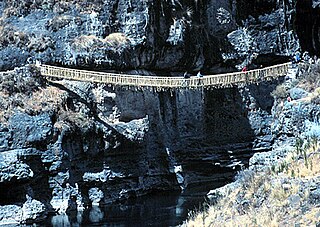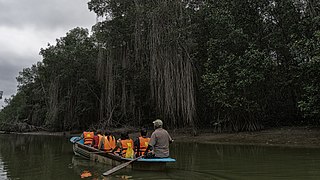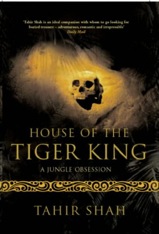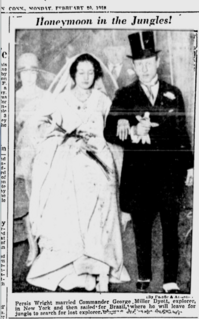Related Research Articles

The Inca Empire, also known as the Incan Empire and the Inka Empire, and at the time known as the Realm of the Four Parts, was the largest empire in pre-Columbian America. The administrative, political and military center of the empire was in the city of Cusco. The Inca civilization arose from the Peruvian highlands sometime in the early 13th century. The Spanish began the conquest of the Inca Empire in 1532 and its last stronghold was conquered in 1572.

Machu Picchu is a 15th-century Inca citadel located in the Eastern Cordillera of southern Peru on a 2,430-meter (7,970 ft) mountain ridge. It is located in the Machupicchu District within Urubamba Province above the Sacred Valley, which is 80 kilometers (50 mi) northwest of Cusco. The Urubamba River flows past it, cutting through the Cordillera and creating a canyon with a tropical mountain climate.

Incana rope bridges are simple suspension bridges over canyons, gorges and rivers (pongos) constructed by the Inca Empire. The bridges were an integral part of the Inca road system and exemplify Inca innovation in engineering. Bridges of this type were useful since the Inca people did not use wheeled transport – traffic was limited to pedestrians and livestock – and they were frequently used by chasqui runners delivering messages throughout the Inca Empire.

Madre de Dios is a department and region in southeastern Peru, bordering Brazil, Bolivia and the Peruvian departments of Puno, Cusco and Ucayali, in the Amazon Basin. Its capital is the city of Puerto Maldonado. It is also the third largest department in Peru, after Ucayali and Loreto. However, it is also the least densely populated department in Peru, as well as its least populous department.

Tumbes is a coastal department and region in northwestern Peru bordering Ecuador. Due to the region's location near the Equator it has a warm climate, with beaches that are considered among the finest in Peru. Despite its small area, the region contains a wide variety of ecosystems. It is the smallest department in Peru and its third least populous department after Moquegua and Madre de Dios, but it is also its third most densely populated department, after La Libertad and Lambayeque.

Vilcabamba, Willkapampa is often called the Lost City of the Incas. Vilcabamba means "sacred plain" in Quechua. The modern name for the Inca ruins of Vilcabamba is Espiritu Pampa. Vilcabamba is located in Echarate District of La Convención Province in the Cuzco Region of Peru.

The Chachapoyas, also called the "Warriors of the Clouds", was a culture of the Andes living in the cloud forests of the southern part of the Department of Amazonas of present-day Peru. The Inca Empire conquered their civilization shortly before the Spanish conquest in the 16th century. At the time of the arrival of the conquistadors, the Chachapoyas were one of the many nations ruled by the Incas, although their incorporation had been difficult due to their constant resistance to Inca troops.
Antisuyu was the eastern part of the Inca Empire which bordered on the modern-day Upper Amazon region which the Anti inhabited. Along with Chinchaysuyu, it was part of the Hanan Suyukuna or "upper quarters" of the empire, constituting half of the Tahuantinsuyu, the "four parts bound together" that comprised the empire.
Paititi is a legendary Inca lost city or utopian rich land. It allegedly lies east of the Andes, hidden somewhere within the remote rainforests of southeast Peru, northern Bolivia or northwest Brazil. The Paititi legend in Peru revolves around the story of the culture-hero Inkarri, who, after he had founded Q'ero and Cusco, retreated toward the jungles of Pantiacolla to live out the rest of his days in his refuge city of Paititi. Other versions of the legend see Paititi as an Inca refuge in the border area between Bolivia and Brazil.
Mameria is an area of high-altitude jungle to the northeast of the Paucartambo range in southeast Peru, drained by the Mameria river, an affluent of the Nistrón river. Until the 1960s this remote and sparsely populated area would have been considered a part of the Callanga jungle area. Machiguenga peoples, fleeing the slavery that they were subject to along the Yavero river, fled to this area which acquired its current name from the Machiguenga observing that "mameri," which means "there are none," regarding the lack of fish in the river.

Inca Gold is a novel written by Clive Cussler. First published in 1994, it is the twelfth book in Cussler's Dirk Pitt series.
The Treasure of the Llanganates refers to a huge amount of gold, silver, platinum and electrum artifacts, as well as other treasures, supposedly hidden deep within the Llanganates mountain range of Ecuador by the Inca general Rumiñahui.

Choquequirao is an Incan site in southern Peru, similar in structure and architecture to Machu Picchu. The ruins are buildings and terraces at levels above and below Sunch'u Pata, the truncated hill top. The hilltop was anciently leveled and ringed with stones to create a 30 by 50 m platform.

The Indigenous peoples of Peru, or Native Peruvians, comprise a large number of ethnic groups who inhabit territory in present-day Peru. Indigenous cultures developed here for thousands of years before the arrival of the Spanish in 1532.

Trail of Feathers is a travel book by Anglo-Afghan author, Tahir Shah. It is set in Peru and the Upper Amazon.

House of the Tiger King is a travel journal in which Anglo-Afghan author Tahir Shah recounts his search for the legendary Inca city Paititi. The book was first published by John Murray in 2004. Its title is a translation of a Machiguenga name for Paititi.

George Miller Dyott was an English pioneer aviator, cinematographer, and explorer of the Amazon. Dyott accompanied Arthur S. Vernay to India and helped produce a documentary on tiger hunting.
House of the Tiger King is a 2014 British–Swedish deconstructionist documentary released in 2004. A British travel writer/explorer, Tahir Shah, and documentary filmmakers David and Leon Flamholc, join forces to go on an expedition to Peru in search of Paititi, the Inca lost city of gold. Things do not go as planned, and on their first attempt, they are forced to give up due to two main setbacks: terrible conditions and troubles with their guide, American survivalist Vietnam-war veteran Richard Fowler. On their second attempt, Flamholc and Shah find various locals to help them, including Eduardo Huamani Padilla. Tensions begin to arise between the two, in part over the difficulties in transporting the amount of camera equipment carried by the film crew, and ultimately Shah leaves the Flamholcs stranded as he continues the journey on his own. The director explains in the voiceover that he will use the best footage to put together a story once he returns home, but that "Whatever it will look like, it will never show what actually happened."
Richard "Aukcoo" Fowler (1948–2016) was an American wilderness guide, naturalist, and former U.S. Army Ranger based in Iquitos, a city in the Peruvian Amazon.
Search for the Lost Treasure of Afghanistan is a 2007 documentary film, in which travel writer and explorer Tahir Shah heads off to Afghanistan, on a quest to find the alleged hidden treasure of Ahmad Shah Durrani. Following the clues in a notebook which was allegedly left to Shah by his ancestors, he teams up with Reza, a young Afghan archeologist and attempts to solve the mystery of the alleged treasure of Ahmad Shah. This film documents some of the adventures that occurred during three trips to Afghanistan between 2005 and 2006.
References
- 1 2 Staff. "SEARCH FOR THE LOST CITY OF GOLD". Archived from the original on 3 December 2013. Retrieved 10 September 2012.
- 1 2 Shah, Tahir. "Search for the Lost City of Gold" . Retrieved 10 September 2012.
- ↑ Staff. "Search for the Lost City of Gold" . Retrieved 10 September 2012.